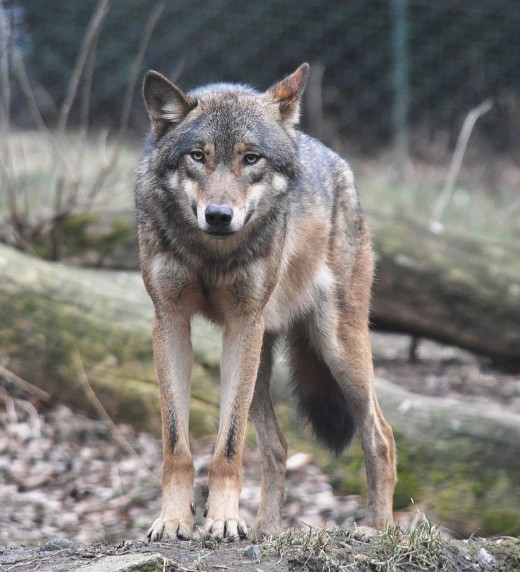Evolution of grey wolf to modern dogs

The domestic dog was considered to be a species of animal in itself but strong evidence from various disciplines led to believing the gray wolf is the ancestor of all present day dog breeds. As a result the domestic dog has been reclassified in 1993 as Canes Lupus Familiarus, or a subspecies of gray wolf, Canis Lupus by the Smithsonian Institution and The American Society of Mammalogists, according to Wikipedia’s article on the dog. The gray wolf includes the timber wolf, arctic wolf, buffalo wolf, and the Mackenzie wolf. The domestic dog is “…the most widely kept working, hunting, and companion animal in history,” Wikipedia states. Possibly dogs were the first domesticated animals and I think the easiest way to follow the evolution is by a timeline.
- · Sixty million years ago Paleocene wolf ancestors were developing.
- · Twenty million years ago Miocene canines and felines developed as a separate species.
- · Tomaretus, wolf ancestor, fifth toe became vestigial and became dew claw on modern dogs and wolves. Possibly in the early Pleistocene, three million years ago: first gray wolf, canis lupus,
- · Eurasia early 750,000 years ago canines migrated to North America
- · Dire wolf, canis dirus, bigger and heavier than gray wolf. Evolved sooner and they co-existed in North America for about 400,000 years.
- · Dire wolf became extinct 7,000 years ago and gray wolf survived as canine predator in North America.(information from “The wolf Almanac” by Robert H. Busch)
Wikipedia estimates that present day domesticated dogs split from the gray wolf about 15,000 years ago. Yet, remains of domesticated dogs have been found in Siberia and Belgium dating to33,000 years ago. None of these lineages, however, seem to have survived the last Glacial Maximum, according to Wikipedia,

DNA tests now indicate that dogs and wolves may have split about 100,000 years ago. Prior to 33,000 years ago no specimens of domesticated dogs seem to exist and most of today’s dog breeds are less than a few hundred year old. Dogs have been used for hunting, herding, pulling loads, protection, police and military work, companions and in various roles, assisting humans who are handicapped. They have been selectively bred for these various purposes and have led to a variety of breeds with different sizes, temperaments and abilities. No other species reflects the variety that dogs do.
We now understand that “domestic dogs inherited complex behaviors from their wolf ancestors,” states Wikipedia. These ancestors were pack hunters and had complex body language. The “forms of social cognition and communication” could be why the dog is trainable, playful and able to fit into human social situations, Wikipedia explains. Experts generally agree that that interaction with humans helped shape the domestication of the dog. It probably occurred in separate areas such as Siberia and Europe. Our current lineage of dogs was probably domesticated between 15,000 and 8500 years ago. Dogs spread around the world after that.
dogs close to wolves DNA
- Tibetan Terrier: good luck charm
Tibetan terriers are an old breed that was sheltered in the mountains for a long time. They are dogs that make nice companions but can also do work. They were the 'holy dogs of tibet - Alaskan Malamute dog:Sled dog, not big Husky
They came from upper Alaska where they were working companions to a native tribe.. They are a Nordic sled dog that descended from the arctic wolf and are often mistaken for wolves.Strong, beautiful and useful dogs. - Basenji: Ancient African hunting dog
Basenji is a dog from Africa which may be best know for its lack of ability to bark. Originally developed as a hunting dog it is one that is closely related genetically to the grey wolf. They are recognized by they wrinkles on heir faces which is sai
It seems to be generally believed about 15,000 years ago, it would be about the time of “a large expansion of human territory,” and the development of agriculture, according to Wikipedia. Some biologists think that this would be an influence on domestication of dogs because established human settlements would have meant “a shift in human lifestyle,” according to Wikipedia. That would have meant more food and a barrier between wild canines and domestic dogs.
Which are oldest breeds?
“Data suggest dogs first diverged from wolves in East Asia…oldest groups of dogs…most similar to their wolf ancestors, are primarily Asian and African breeds,…basenji, Lhasa Apso, and Siberian Husky.” Wikipedia states. On the other hand some breeds once “thought to be very old, such as the Pharaoh Hound, Ibian Hound, and Norwegian elkhound,” are more recent.
Although the greywolf and domestic dog are still related enough that they can interbreed, the evolution of the domestic dog, with the help of selective breeding has diverged into several basic dog groups.
· Sight hounds: or gazehounds seek game by focusing on the horizon hunting by sight. Their characteristics are good vision, a long jaw and long neck to assist in sighting game. A lean and muscular body, deep chest and strong legs help in following fast and agile game.
· Scent Hounds: Rather than being fast and agile, the scent hound needs endurance. They can follow a scent for long distances over various terrain, even water. They have large noses, with deep. Their lips are loose and moist. Their ears are long and helps concentrate the scent on the nose.
· Working group: These are dogs that do herding, droving, pulling, hauling, hunting, rescuing and guarding.
· Sporting dogs: Include Retrievers, Pointers, and setters
· Terrier Breeds: Originally used to hunt and kill rats, mice and other animals that may raid a farmers livestock and produce
· Non-sporting Breeds: These are breeds that were developed originally for things like bull baiting when that was considered entertainment.
· Toy dog breeds
Note: Information on dog groups cited above is from the Dog names and breeds article on History and evolution of dogs website.
List of ancient dogs
The following list can be found in Wikipedia, dog guide.net, and other sources.
1. Afghan Hound
2. Akita Inu
3. Basengi
4. Chow Chow
5. Lhasa Apso
6. Malamute
7. Pekinese
8. Siberian Husky
9. Shar Pei
10. Shiba Inu
11. Saluki
12. Samoyed
13. Shih Tzu
14. Tibeta Terrier
Summary:
It wasn’t until the use of DNA evidence that scientist were able to trace the relationship of the domestic dog to the greywolf and to better understand the evolution of the dog. Some dogs which were once thought to be very old breed turn out to be more recent and other dogs are discovered to be older breeds. The modern dog is very much a product of selective breeding over time for particular reasons and the various groups of dog classification reflect that.




